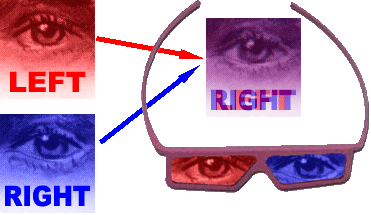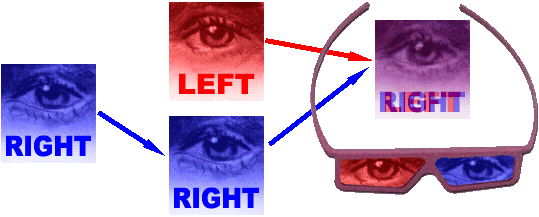|
Active versus Passive 3D Displays There are two prominent methods for displaying stereoscopic images using computers: active and passive. Active Display
The active display operates by very rapidly alternating between the left-eye and the right-eye image in the same space. Usually, this is done at about twice the frame-rate necessary for continuity of motion (120Hz). Special glasses must be worn in order to view this method. These glasses have lenses which turn from opaque to transparent in perfect synch with the transformation of the image. The left image is only displayed when the left lens is transparent (and the right one is opaque) and vice versa. Many computer programs (Java3D) output active 3D images. The trouble is that the glasses to view them are rather expensive, making this infeasible for larger groups. You must also be sitting at a computer that has the proper hardware. Glasses must communicate with the program so that they image/shutter sequence can be properly synched. This can be done through a wire connected to the computer or using infrared emitters. Passive Display
The passive method of displaying stereoscopic images is better suited for large groups, since the expensive technology is primarily in the display rather than each pair of glasses (polarized glasses run about $1.20 a pair). This is the method that Geowall utilizes. The concept is simple; project both the left eye and the right eye simultaneously into the same space, and then use a special set of glasses which shows each image to its intended eye while blocking out the unintended image from that eye. The Conversion of Active to Passive
Because we were doing our code in Java3D which has a function for active output, we spend some time looking for a way to convert the active 3D image created by Java3D into a passive image which could be utilized in Geowall. What we found was a single piece of $8,000 - $12,000 hardware that could do the job. We have been told that the $8,000 unit doesn't work and we demoed the $12,000 unit, which worked. In any case, it was a lot of money for a little functionality that upon further exploration we determined to be unnecessary.
This was the only solution we found, which surprised us. We remain convinced that there must be a software solution that sends one image to one monitor and the other image to the other monitor, but we didn't find it. |



